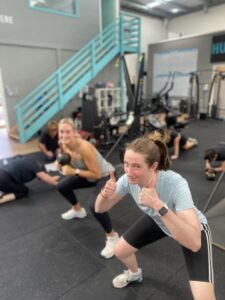Have you ever found yourself torn between hiring a personal trainer and joining those bustling group fitness sessions? I certainly have. Last year, I was struggling to maintain consistency in my fitness journey. Solo workouts left me unmotivated, while large group classes made me feel lost in the crowd. That’s when I discovered the sweet spot – small group training. This revolutionary approach combines the personalised attention of one-to-one coaching with the energetic atmosphere of group workouts, all at a price point that won’t leave your wallet gasping for air.
Small group training has transformed not just my physical fitness but my entire approach to exercise. The camaraderie, accountability, and expert guidance have helped me achieve results I never thought possible.
In this comprehensive guide, we’ll explore what small group training actually entails, how it differs from traditional group fitness classes, and most importantly, the five extraordinary benefits that make it the ideal fitness solution for people at all stages of their wellness journey. Whether you’re looking to shed pounds, build strength, or simply establish a consistent exercise routine, small group training might just be the game-changer you’ve been searching for.

What Exactly Is Small Group Training?
Small group training represents a specialised fitness approach that bridges the gap between personalised coaching and community-based exercise. Unlike traditional workout methods, this format typically involves a qualified fitness professional working with a limited number of participants—usually between three and ten individuals—in a focused, goal-oriented environment.
The intimate nature of these sessions creates a unique dynamic where each participant receives substantial individual attention while still benefiting from the motivational aspects of group exercise. Think of it as having a shared personal trainer who designs workouts tailored to the collective goals of the group while still accounting for individual fitness levels, limitations, and aspirations.
What truly distinguishes small group training is its purposeful structure. Rather than following a generalised exercise programme, these sessions often target specific fitness objectives. For instance, you might join a small group dedicated to strength development, high-intensity interval training (HIIT), weight management, or functional fitness. This targeted approach ensures that every minute of your workout contributes meaningfully to your personal fitness journey.
The setting for these sessions varies widely across fitness facilities. Some gyms dedicate specialised zones equipped with versatile training tools like kettlebells, battle ropes, and suspension trainers. Others might utilise studio spaces or even outdoor environments to create diverse workout experiences. This flexibility in location and equipment allows trainers to design creative, engaging sessions that prevent the monotony that often plagues traditional exercise routines.
Perhaps most importantly, small group training fosters a sense of community and shared purpose that’s difficult to achieve in other fitness contexts. When you join such a group, you’re not just signing up for a workout—you’re becoming part of a supportive micro-community where everyone is working toward similar goals, facing similar challenges, and celebrating each other’s victories along the way.
Small Group Training vs. Group Fitness Classes: Understanding the Difference
While both formats involve exercising alongside others, the distinctions between small group training and traditional group fitness classes are significant and worth understanding before you commit to either option. The most obvious difference lies in the participant numbers. Standard group fitness classes often accommodate anywhere from 15 to 40 participants, creating an energetic but potentially overwhelming environment. In contrast, small group training maintains an intimate atmosphere with typically no more than ten participants, ensuring you’re never just another face in the crowd.
This size difference directly impacts the level of personalisation you’ll receive. In conventional group classes, instructors primarily demonstrate movements from the front of the room, offering occasional corrections but rarely providing individualised guidance. The standardised nature of these classes means everyone follows the same routine regardless of their fitness level or specific needs. Small group training, however, operates on a different philosophy entirely. Trainers actively engage with each participant, offering form corrections, intensity modifications, and personalised encouragement throughout the session. This hands-on approach means your workouts are effectively tailored to your capabilities even within the group context.
The programming structure also differs substantially between these two formats. Group fitness classes typically follow a set template—think of your standard spin class or aerobics session that remains relatively consistent each week with minor variations. Small group training employs progressive programming that evolves as participants advance, with workouts building upon previous sessions to create a coherent fitness journey rather than isolated exercise experiences. This methodical progression helps prevent plateaus and ensures continuous improvement over time.
Another crucial distinction is the commitment structure. Group fitness classes generally operate on a drop-in basis, allowing participants to attend whenever convenient without ongoing obligation. While this flexibility appeals to many, it can undermine consistency. Small group training usually involves a scheduled commitment—participants sign up for specific sessions or programme durations, creating accountability and fostering regular attendance. This structured approach significantly increases the likelihood of achieving meaningful fitness results.
The social dynamics also differ markedly between these formats. Large group classes can create a sense of anonymity despite the shared space, with limited interaction between participants. Small group training naturally fosters connections as you work closely with the same individuals session after session. These relationships often extend beyond the workout itself, creating a supportive network that enhances motivation and enjoyment of the fitness process.

Benefit 1: Personalised Attention Without the Premium Price Tag
One of the most compelling advantages of small group training is the exceptional level of personalised guidance it offers without the substantial financial investment typically associated with one-to-one coaching. In traditional personal training scenarios, you receive undivided attention from a fitness professional—but at a premium rate that can range from $90 to $150 per hour in most fitness facilities. This cost barrier prevents many individuals from accessing the expert guidance they need to exercise safely and effectively.
Small group training revolutionises this dynamic by distributing the trainer’s cost across multiple participants while maintaining a ratio that still allows for meaningful individual attention. With only 3-10 people in each session, trainers can monitor your form, provide real-time feedback, and make appropriate modifications based on your specific needs. This means you’ll perform exercises correctly, minimising injury risk while maximising results—benefits typically reserved for those who can afford private coaching.
The personalisation extends beyond mere form correction. Skilled small group trainers excel at scaling exercises to accommodate different fitness levels within the same session. For instance, while one participant might perform traditional push-ups, another might modify with knee-supported variations, and a more advanced member might add a plyometric element—all within the same workout block. This intelligent exercise scaling ensures everyone feels appropriately challenged regardless of their starting point.
What’s particularly valuable about this format is the opportunity for immediate feedback loops. When you exercise independently, you might spend weeks or months performing movements incorrectly before realising your mistake—if you realise it at all. In small group settings, trainers can instantly identify and address technique issues, accelerating your learning curve and preventing the development of poor movement patterns that could lead to injury or stalled progress.
The financial mathematics makes this option extraordinarily appealing. While individual personal training sessions might cost $100 on average, small group sessions typically range from $25 to $40 per person. This represents a 60-75% cost reduction while retaining many of the benefits of personalised training. For many fitness enthusiasts, this sweet spot of affordability and personalisation makes consistent, expert-led training sustainable over the long term—something that might be financially prohibitive in a one-to-one context.

Benefit 2: Accelerated Results Through Expert Programming
The journey toward fitness goals can often feel like navigating without a map when you’re exercising independently. One of the most significant advantages of small group training is access to professionally designed exercise programmes that systematically move you toward your objectives. Unlike random workout selection or following trending exercise routines from social media, small group training provides structured, progressive programming created by qualified fitness professionals.
This expert approach to exercise design eliminates the guesswork that plagues many fitness journeys. Trainers carefully sequence workouts to build upon previous sessions, creating a logical progression that challenges your body appropriately without overwhelming it. This methodical approach prevents the common plateau effect that occurs when individuals repeat the same exercises at the same intensity week after week. Instead, variables like volume, intensity, complexity, and rest periods are strategically manipulated to continually stimulate adaptation.
The effectiveness of small group programming stems from its periodised structure. Rather than approaching each workout as an isolated event, trainers develop training blocks—typically spanning 4-8 weeks—with specific phases focused on building foundations, intensifying effort, and strategic recovery. This cyclical approach mirrors the methods used by elite athletes but is scaled appropriately for everyday fitness enthusiasts. The result is consistent progress without the burnout or injury risk associated with haphazard training approaches.
Another acceleration factor comes from the efficiency of movement selection. Qualified trainers prioritise compound exercises that engage multiple muscle groups simultaneously, maximising the metabolic demand and functional benefits of each movement. Rather than isolating individual muscles with single-joint exercises (as many gym-goers tend to do), small group workouts emphasise integrated movements that reflect real-world physical demands. This approach not only saves time but also develops useful strength that translates to daily activities.
The programming advantage extends beyond the sessions themselves. Many small group training programmes include homework assignments—supplementary workouts or recovery practices to complete between scheduled sessions. This comprehensive approach ensures that your fitness development continues even when you’re not directly under the trainer’s supervision. For instance, you might receive mobility exercises to perform on rest days or nutrition guidance that complements your physical training, creating a holistic system for accelerated results.

Benefit 3: Unmatched Motivation Through Positive Group Dynamics
The psychological aspects of exercise adherence often prove more challenging than the physical demands themselves. Small group training harnesses powerful social psychology principles to keep you consistently engaged and pushing beyond perceived limitations. This motivational environment stems from several interconnected factors that simply don’t exist when exercising alone or in oversized fitness classes.
The Köhler Effect represents one of the most fascinating psychological phenomena at work in small group settings. This principle suggests that no one wants to be the “weakest link” in a group effort, naturally encouraging individuals to work harder than they would independently. Research published in the Journal of Sport and Exercise Psychology demonstrates that participants exert up to 24% more effort when working in group settings compared to solo exercise. This subconscious motivation boost occurs naturally without creating negative pressure or unhealthy competition.
Beyond this performance-enhancing effect, small group training creates a unique accountability structure that significantly improves attendance consistency. When you book into a specific session with a limited participant cap, your presence (or absence) is noticeable. This visibility creates both external accountability to the trainer and fellow participants and internal accountability through commitment consistency. Simply put, you’re much less likely to skip a workout when others are expecting you and when you’ve secured a limited spot in advance.
The social connections formed in these intimate training environments also generate substantial motivational benefits. As you share the challenge of difficult workouts with the same individuals session after session, natural bonds develop. These relationships often extend beyond mere workout acquaintances to become genuine friendships built on shared experiences and mutual support. The resulting social network becomes a powerful motivation to attend sessions even on days when your internal drive might be lacking.
Perhaps most importantly, small group training creates regular opportunities for celebration and recognition. Whether it’s acknowledging someone’s first full push-up, recognising consistent attendance, or celebrating collective progress toward fitness goals, these moments of positive reinforcement generate neurochemical rewards that strengthen exercise adherence. The combination of dopamine (from achievement) and oxytocin (from social bonding) creates a powerful neurological incentive system that makes the exercise experience inherently more rewarding.

Benefit 4: Enhanced Commitment Through Structured Accountability
Consistency remains the single most important factor in achieving lasting fitness results, yet it’s precisely where most independent exercisers struggle. Small group training excels at creating multiple layers of accountability that significantly improve adherence rates compared to solo workouts or casual group fitness participation. This structured commitment framework helps transform exercise from an occasional activity into a non-negotiable part of your routine.
The financial investment itself serves as the first accountability layer. When you’ve pre-paid for a series of sessions, the sunk cost creates a psychological incentive to attend. Unlike monthly gym memberships that continue whether you show up or not, small group training typically involves package purchases or session bookings that feel “wasted” if unused. This financial commitment activates loss aversion—a powerful psychological principle where the pain of losing something outweighs the pleasure of gaining something equivalent.
Beyond financial considerations, small group training establishes clear attendance expectations. Many programmes require advance booking with cancellation policies, creating a formal commitment structure. Some formats even implement “three strikes” policies where consistent no-shows result in forfeiting your reserved spot to waitlisted participants. These policies might seem strict, but they effectively communicate that your presence matters and that consistency is valued within the programme.
The relationship with your trainer provides another powerful accountability mechanism. Unlike large group fitness classes where instructors might not notice your absence, small group trainers develop personal connections with each participant. They’ll likely notice when you miss sessions and follow up appropriately. This professional oversight creates external accountability that many find helpful, particularly during motivation slumps or challenging life periods when exercise might otherwise be deprioritised.
Perhaps most effective is the peer accountability that naturally develops within consistent groups. As you train alongside the same individuals regularly, you become invested in each other’s journeys. Missing sessions becomes not just a personal choice but a noticeable absence to people who have come to expect your presence. This social accountability often proves more motivating than any external system, as it connects to our fundamental human desire for belonging and community participation.
The structured nature of small group programmes also creates natural measurement points that enhance commitment. Many formats include periodic assessments, benchmark workouts, or progress tracking that provide tangible evidence of improvement. These objective measurements combat the perception plateaus that often lead to exercise abandonment, helping participants recognise progress they might otherwise miss and reinforcing the value of their consistent effort.

Benefit 5: Comprehensive Fitness Development Beyond Physical Results
While physical transformations often motivate initial interest in fitness programmes, small group training delivers a spectrum of benefits that extend far beyond aesthetic changes or performance metrics. This comprehensive approach to wellness addresses multiple dimensions of health simultaneously, creating holistic improvements that enhance overall quality of life.
The varied training modalities typically incorporated into small group programmes ensure balanced physical development. Unlike specialised fitness approaches that might focus exclusively on cardiovascular endurance or strength, small group sessions generally incorporate multiple fitness components within each workout or across a weekly schedule. This balanced approach prevents the common pitfall of overemphasising certain fitness aspects while neglecting others. For instance, a well-designed programme might include strength training, cardiovascular conditioning, mobility work, and coordination challenges—creating well-rounded physical capabilities rather than isolated fitness attributes.
Beyond physical development, small group training cultivates valuable mental skills that transfer to daily life. The challenge of mastering new movement patterns enhances neuroplasticity—your brain’s ability to form new neural connections. Learning complex exercise sequences or mastering technical movements improves cognitive function in ways that extend beyond the gym. Additionally, the intensity of challenging workouts builds mental resilience and discomfort tolerance. As you push through difficult intervals or hold challenging positions, you develop psychological resources for navigating life’s inevitable challenges.
The social dimension of small group training addresses an often-overlooked aspect of modern wellness. In an increasingly digital world where genuine human connection has diminished, these training groups provide authentic in-person interaction centered around positive shared experiences. The relationships formed often extend beyond workout sessions to create meaningful social connections. For many participants, especially those working from home or in isolated professional environments, these interactions fulfils important social needs that contribute significantly to mental wellbeing.
Small group formats also excel at developing intrinsic motivation—the internal drive to exercise for its inherent satisfaction rather than external rewards. While many begin fitness programmes focused on extrinsic motivators like weight loss or appearance changes, research indicates these motivations rarely sustain long-term adherence. The supportive environment and emphasis on process over outcomes in small group training helps participants discover internal motivations like enjoyment, competence development, and connection. This motivational shift transforms exercise from an obligation into a valued activity, dramatically improving long-term adherence.
Perhaps most importantly, small group training fosters a growth mindset around physical capability. Rather than viewing fitness as fixed or determined by genetics, participants experience firsthand how consistent effort leads to improvement. This experiential learning combats limiting beliefs about age, natural ability, or previous athletic experience. As participants witness their own progress and that of their peers, they develop a fundamental understanding that physical capacity can expand through dedicated practice—a perspective that encourages lifelong engagement with physical activity.
Finding the Right Small Group Training Program for Your Needs
With the growing popularity of small group training, fitness enthusiasts now face abundant options—from boutique studios specialising exclusively in this format to traditional gyms incorporating small group offerings alongside their standard services. This variety creates wonderful opportunities but can also generate confusion when determining which programme best aligns with your specific needs and preferences.
The first consideration should be the trainer’s qualifications and expertise. Unlike regulated professions, the fitness industry permits considerable variation in certification requirements and educational backgrounds. Look for trainers who hold recognised qualifications from reputable organisations or university degrees in relevant fields. Beyond paper credentials, investigate their practical experience, particularly with small group formats. Leading effective small group sessions requires distinct skills from personal training or large group instruction—namely, the ability to provide individualised attention within a group context while maintaining session flow and energy.
Programme structure represents another crucial factor in your selection process. Some small group offerings operate on a drop-in basis similar to traditional group fitness, while others employ cohort models where the same participants progress through a defined programme together. The latter approach typically delivers superior results through progressive programming but requires greater scheduling commitment. Additionally, examine the participant-to-trainer ratio carefully. While small group training technically includes any format with 3-10 participants, the experience differs significantly between a session with three people versus ten. Consider your personal preference for attention level when evaluating these ratios.
Specialisation versus variety presents another important consideration. Some small group programmes focus exclusively on specific training methodologies—like strength training, HIIT, or functional fitness—while others incorporate diverse approaches. Specialised programmes typically attract participants with similar goals and often deliver superior results in their specific domain. Varied programmes offer more balanced fitness development and prevent monotony but might progress more slowly in any single fitness component. Your selection should align with your primary objectives and personality preferences regarding routine versus variety.
Practical considerations like location, scheduling options, and cost structure will inevitably influence your decision. Even the most exceptional programme provides limited value if attending consistently proves logistically challenging. Evaluate whether the schedule accommodates your availability, the location facilitates regular attendance, and the pricing structure aligns with your budget. Some programmes offer package rates for multiple sessions, while others operate on membership models or pay-as-you-go systems. Consider which approach best motivates your consistent participation.
Finally, don’t underestimate the importance of community fit and training atmosphere. The social dynamics of small group training significantly impact your experience and adherence. Most reputable programmes offer trial sessions or introductory packages that allow you to experience the environment before making a longer-term commitment. During these trials, assess not just the workout quality but also the group culture, communication style, and overall atmosphere. Finding a community where you feel both challenged and supported dramatically increases your likelihood of long-term engagement and success.

Conclusion: Is Small Group Training Right for You?
Small group training offers a remarkable combination of personalised attention, expert programming, motivational support, structured accountability, and comprehensive fitness development—all at a price point significantly more accessible than private coaching. For many fitness enthusiasts, this format represents the ideal balance between individualisation and affordability, delivering exceptional value and results.
However, like any fitness approach, small group training isn’t universally perfect for everyone. Those requiring rehabilitation from significant injuries or managing complex medical conditions might initially benefit from one-to-one attention before transitioning to small group formats. Similarly, individuals with highly specific athletic goals or unusual scheduling requirements might need the complete customisation that only personal training provides.
For the vast majority of people seeking improved fitness, health, and wellbeing, small group training offers an unmatched combination of benefits that address both the physical and psychological aspects of sustainable exercise habits. The format effectively solves the most common barriers to fitness success: knowledge gaps, motivation fluctuations, accountability challenges, and prohibitive costs of individualised guidance.
If you’ve struggled with consistency in self-directed workouts or felt lost in large fitness classes, small group training might be the missing piece in your wellness puzzle. Consider exploring this option through introductory offers at reputable facilities, and experience firsthand how the right combination of expert guidance and supportive community can transform your fitness journey.
To learn more about our Small Group Training Programs CLICK HERE to speak with a coach today!




